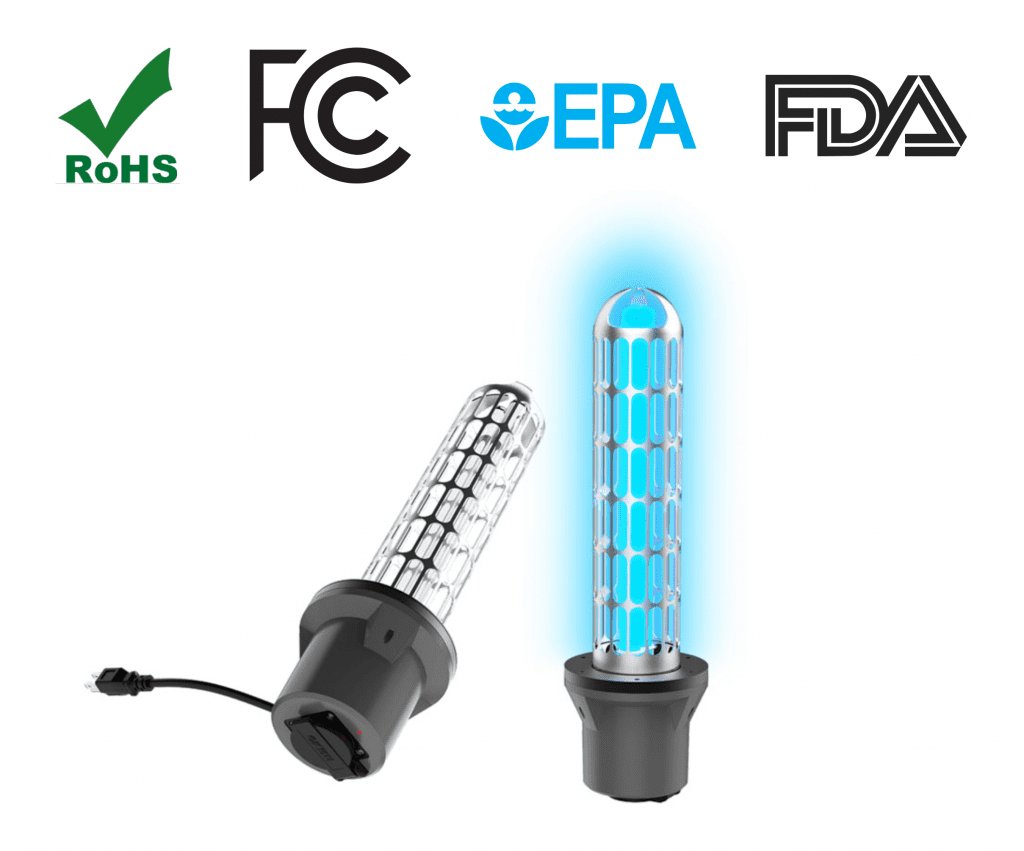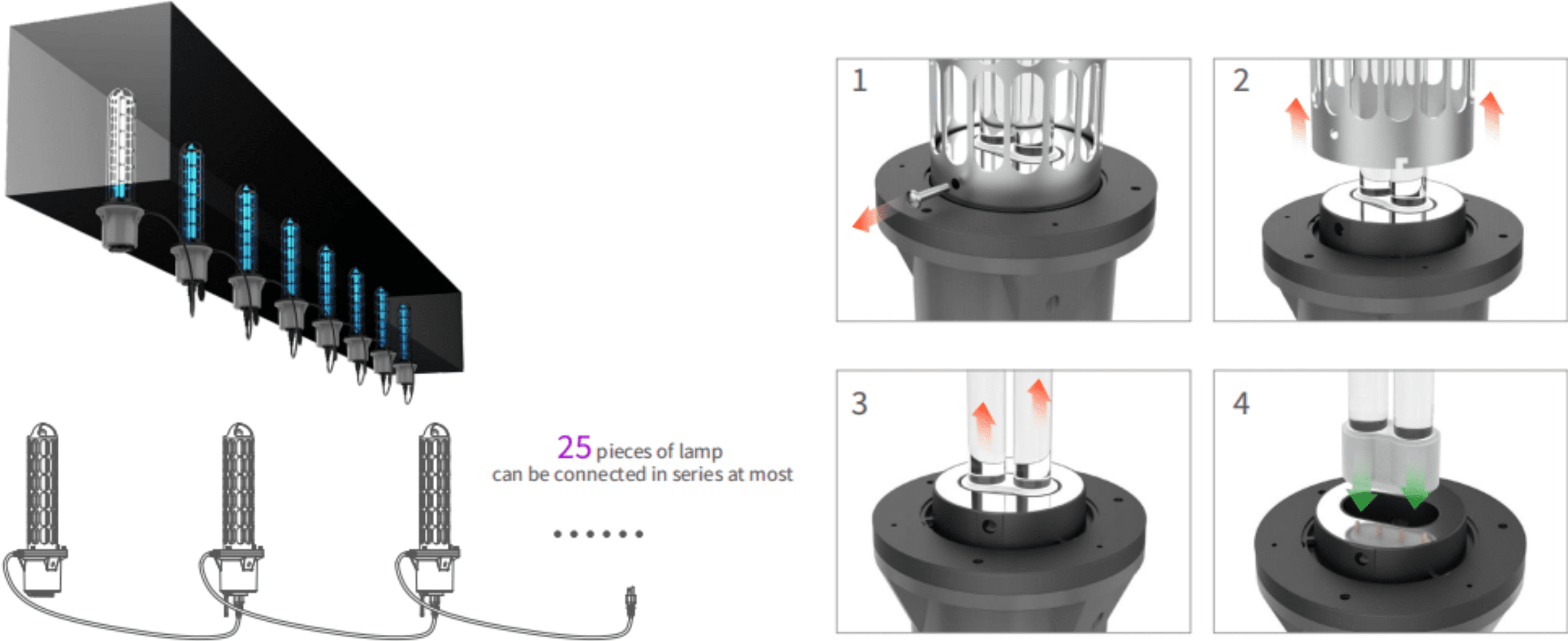
This product is specially designed for the purification of ventilation ducts. The air flowing into the ventilation duct can be purified before flowing into the room. Because the UVC irradiation component is confined to the ventilation duct, it is completely safe for the human body. the 254nm high power UVC quartz lamp can kill bacteria in a 3600 radius.
Applications
- Office Buildings
- Hospital / Health Care Facilities
- Gymnasiums
- Schools / Universities
- Residential / Hotels
- Supermarkets / Retail Environments
- Restaurants / Entertainment Centers
- Industrial / Factory
- Laboratory / Research Facility
Product Features
Safe and Reliable
UVC lamps operate in a closed HVAC space without leaking ultraviolet radiation ensuring safety for humans, animals and plants.

360 Degree Ultraviolet Purification
Built-in 254nm high efficiency UVC quarrtz lamp tube, all around radiation, 3600 purification.

Convenient Series Connection With Replaceable UVC Lamp Tube
Lamp plugs are wired in series with up to 25 lamps connected. Easy replacement of quartz UVC tube.

Indicator Light to Show Working Status
During routine maintenance if the UVC lamp is damage or has poor electrical contact, the indicator light will turn from green to red, which ensures that the abnormal status of the lamp can be directly discovered without disassembly, protecting the safety of maintenance personnel.

Specifications
| Power (W) | 24W | |||
| Input Voltage (V) | 100-277VAC | |||
| Wavelength (nm) | 254nm | |||
| Irradiance From 1 Meter (µW/cm2) | 46.47µW/cm2 (Ambient Temperature 250C) | |||
| Applicable Environment | Ventilation system | |||
| Lamp Type | 24W H-type quartz purification lamp tube | |||
| Service Life of Lamp Tube | >8000h | |||
| Cord Length | 1.5 meters |
|||
| Plug Type | American Standard | |||
| Working Temperature | -50C ~ +400C |
|||
| Product Size (mm) | 125mm*125mm*439mm |
|||
| Warranty | 3-year warranty for fixture, 1-year warranty for UVC lamp tube |
|||
Download Product Cut Sheet
Application Examples


Request a Quote
Knowledge Base
Are UV lights good for HVAC systems?
UV lights are the best way to keep the air you breathe safe. They’re inexpensive, effective, and easy to maintain, making them a no-brainer for anyone with a home HVAC system.
What size UV light do I need for my HVAC system?
To calculate the required intensity for your HVAC system, multiply your airflow rate by 12. For example, if your system has an airflow rate of 2,000 CFM, you will need a UV light system with an intensity of at least 24,000 μW/cm² (2,000 CFM x 12).
What are the cons of UV-C light?
UVC is dangerous to humans. That is why UV sterilization is usually done using UVC lamps with protective shields. Remember to avoid direct exposure to UVC, especially skin and eyes. It is able to kill all kinds of microorganisms, including drug resistant bacteria.
Do HVAC UV lights use a lot of electricity?
However, the reality is that UV lights do not use that much electricity. UV lamps are actually quite dim, so there is not a huge power durian. On average, it costs about 7 cents per day to operate a germicidal UV lamp inside your HVAC system.
How much does it cost to install UV lights in HVAC?
Despite the major benefits that they can provide, UV lights are generally one of the most affordable options for quickly improving your home’s indoor air quality. You should usually expect to pay somewhere between $200 and $1,000 for both the lights themselves and installation.
What is the life expectancy of a UV light for HVAC?
Most manufacturers recommend that you replace your UV lamp every 9,000 hours or approximately every 12 months. An annual replacement schedule is also recommended for those suffering from allergies and other respiratory conditions.
Do HVAC UV lights create ozone?
UV lights are a safe and effective way to improve air quality. They do not produce any ozone or other harmful byproducts. Your air handler, heating or cooling systems, or any type of HVAC system you have will do more than manage the temperature in your home. They will remove allergens, microorganisms, and more.
Do HVAC UV lights smell?
In short, the use of these lights is not hazardous inside the system and any metallic odors you smell may be the result of the production of ozone gas by the UV-C lights. When UV-C light shines on metals, the light has sufficient energy to eject electrons from many metals, especially aluminum.
Do HVAC UV lights get hot?
The short answer is, yes! UV lights do indeed get hot when they are turned on. But, they aren’t as hot as an incandescent bulb can get. An average UV light will reach about 50 degrees Celsius (122 degrees Fahrenheit)
Does UV light damage AC coils?
Algae makes it necessary to clean these components out often. UV lighting will prevent algae formation and reduce the amount of maintenance you have to do. These lights also minimize the risk of equipment damage and extend the lifespans of air conditioners.
Do UV lights go in supply or return?
Depending on your needs and the system you choose, you may install the UV lights directly in the air handler. In addition to the air handler, you may choose to install them in the air return or in strategic areas throughout the ductwork.
Should UV light go before or after cooling coil?
A UV light purification system should be mounted next to and downstream of the evaporator coil, with light directed on both the cooling coil and the water drain pan under the coil, a prime breeding spot for spore germination.
Can I add a UV light to my furnace?
An ultraviolet (UV) lamp can be added to your existing HVAC system and installed in the evaporator coil or ductwork near the coil.
Should HVAC UV light stay on all the time?
For example, UV lights fitted in the air handler will be on all the time. In contrast, those placed inside the ductwork will only need to be on when the AC is running.
What size UV light do I need for my HVAC system?
Calculate the Required UV Light Intensity
To calculate the required intensity for your HVAC system, multiply your airflow rate by 12. For example, if your system has an airflow rate of 2,000 CFM, you will need a UV light system with an intensity of at least 24,000 μW/cm² (2,000 CFM x 12).
